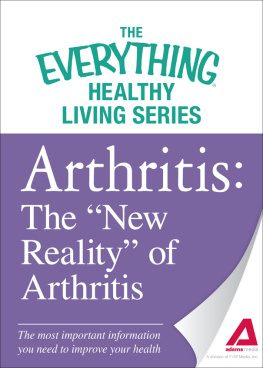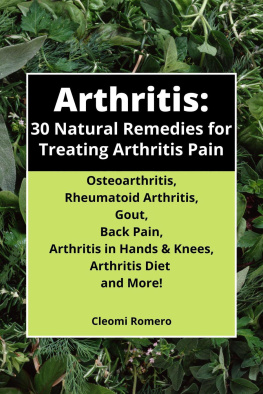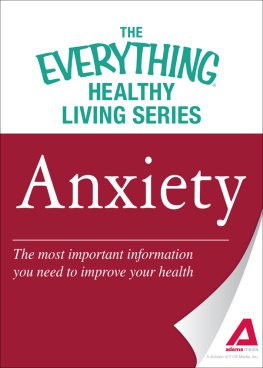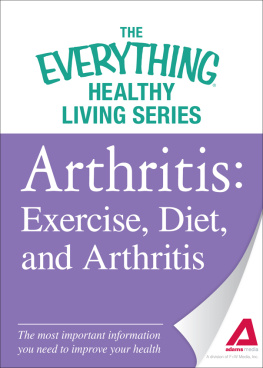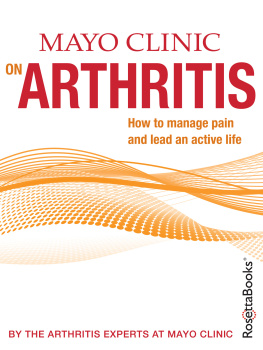Adams Media, a division of F+W Media, Inc.
For more than 10 years, millions of readers have trusted the bestselling Everything series for expert advice and important information on health topics ranging from pregnancy and postpartum care to heart health, anxiety, and diabetes. Packed with the most recent, up-to-date data, Everything health guides help you get the right diagnosis, choose the best doctor, and find the treatment options that work for you.
The Everything Healthy Living Series books are concise guides, focusing on only the essential information you need. Whether youre looking for an overview of traditional and alternative migraine treatments, advice on starting a heart-healthy lifestyle, or suggestions for finding the right medical team, theres an Everything Healthy Living Book for you.
Arthritis
It can be completely unnerving to have nothing wrong with you one day and severe pain the next day. Since pain is a somewhat common symptom associated with many different conditions, it is hard to know initially what to do or how to react to the sudden change. Not every type of arthritis develops suddenly, but that sense of confusion that builds when you accept that its not going to go away can sometimes lead you down the wrong path.
No matter what type of arthritis you have, early diagnosis and early treatment can help prevent joint damage and disability. There are many approaches to treating arthritis, both conventional and alternative. There are myriad books written on the subject. The Internet provides even more information about arthritis. It can almost be considered too much information, because a person experiencing the initial onset of arthritis symptoms often doesnt know where to begin. Should you pick up a book about osteoarthritis and learn all about it? Maybe you should choose the book about rheumatoid arthritis? Perhaps its sufficient to self-treat with over-the-counter arthritis medications? How do you know you are making the right decisions?
Choosing the right starting point can impact the course of your disease. Its imperative to be evaluated by a rheumatologist, a specialist in diagnosing and treating arthritis and related conditions. Getting an accurate diagnosis is the first step to getting proper treatment and managing the disease.
Chronic arthritis affects every aspect of daily living. This practical guide will show you how to live better with arthritis. The day you are diagnosed with arthritis is the first day of your new reality. Your new reality can overwhelm you, or you can choose to face it with courage and perseverance. Your willingness to accept your new reality and adjust and adapt to it, as well as your ability to cope and an unwillingness to give up, are all factors that will influence how well you live with arthritis.
The intent of this book is to help you learn about the disease, teach you to be your own advocate, help you make better decisions, and inspire you to realize that there is still a high quality of life after an arthritis diagnosis. The first step: Understanding that change is inevitable.
If youd like to learn more about arthritis, check out The Everything Health Guide to Arthritis , available in print (978-1-59869-410-9) and eBook (978-1-60550-230-4) formats.
Arthritis Brings a New Reality
Its much easier to talk about the basic facts of arthritis than to consider the uncertainties of living with a chronic disease. On a day-to-day basis, aspects of what are considered normal living can be affected by arthritis. Your home life and work life can be changed. As you would expect, people with disabling types of arthritis and those with a severe course of the disease face the most change in their lives. In most cases, the new reality arthritis brings occurs gradually.
Can You Keep Working?
As arthritis progresses, depending on your job responsibilities, it may become increasingly difficult to continue working. People who have physical jobs and spend a majority of the work day standing, walking, lifting, or reaching, as well as people whose jobs require manual dexterity, face challenges which may become greater if arthritis is uncontrolled or symptoms worsen.
Its hard to know what to do as working becomes more difficult. It becomes a tug of war between hanging on to your job and acknowledging you can no longer work. Its probably one of the most difficult decisions you will ever have to make deciding that you are truly disabled and can no longer work. Many people faced with that decision feel that the disease has won if they concede to being disabled. It should not be viewed as winning or losing; arthritis can be life changing and it brings new realities.
Twenty years ago, over one half of individuals with rheumatoid arthritis who worked before onset of the disease stopped working within ten years of diagnosis. It is one of the goals of newer treatments to keep people working longer and prevent disability. Clearly, people with arthritis try to work as long as possible, both for economic reasons and for the satisfaction that comes from living a productive life. Being aware of how arthritis can affect your ability to work may help you plan ahead and make adjustments that will keep you working.
Fact
According to the CDC, arthritis and other rheumatic conditions are recognized as the leading cause of disability in the United States. Approximately 30.6 percent of adults aged 1864 with doctor-diagnosed arthritis report an arthritis-attributable work limitation.
Communicate with Your Employer
Its a common dilemma for people who are having difficulty at work should you tell your boss arthritis is affecting your work or should you hide it as long as you can? The fear of losing your job may hold you back from talking to your boss and opening up the lines of communication. Its up to you to decide when the time is right to discuss your medical condition with your boss or employer. Dont assume the discussion will have a negative impact on your job, though. With the right approach, you may be able to find a solution that will help you stay on the job and perform better.
Depending on your work responsibilities, you may be able to request a flexible schedule, adaptations to your work environment, a different position that is less physically demanding, and a change from full time to part time.
Be aware that some of the changes listed above may result in alterations to your benefits. Before you change positions or switch from full time to part time, discuss the effect it may have with your employer or benefits manager. The change may keep you working and may be worth a cut in pay or less benefits if it comes to that. You want to make informed decisions and avoid surprises.
Communicate with Your Co-workers
You may find solace in the understanding you will receive from your co-workers. Be open with them and help them understand. Explain why certain tasks are difficult for you or why you limp some days but not others. Dont expect them to know and dont be annoyed at their lack of knowledge with regard to arthritis.
You still have a responsibility to be productive at your job. No one is going to do your job for you. Yet, the small acts of kindness your co-workers may offer from time to time, such as lifting a box for you or reaching something from a top shelf, can help tremendously. Even just having their moral support throughout the workday is uplifting.

